During the private flying boom in the early '50s, America fell in love with Cessna Aircraft Company's high-wing singles. By the mid-'70s, Cessna had built more single-engine airplanes than any other manufacturer (100,000 by 1978). In the late '70s, production peaked for all new airplanes, including Cessna singles, and then sharply tapered off (the production line was actually dormant from 1987 to 1996). Thankfully, Cessna restored piston-engine production in 1997; the first models to return were the ever-popular 172 and 182. Sporty's Pilot Shop gave away one of the first new Cessna 172s as its 1997 Grand Sweepstakes Prize. Response to the new 172 was so positive that Cessna dealers quickly sold out of their allotments.
Cessna delivered approximately 360 new 172s and 182s in 1997. The "new" Cessnas offered significant improvements over the older models, but retained the ease of flying qualities that had made them favorites for 40 years.
How To Decide
New Cessna models offer such a variety in terms of performance that they fit the skill levels and flying needs of most GA pilots. These Cessnas are simple enough to fly that a qualified student pilot should be safe and comfortable. Acquisition costs, operating costs and capabilities, however, will differ. Examine your specific flying requirements and then match them to an appropriate Cessna model.
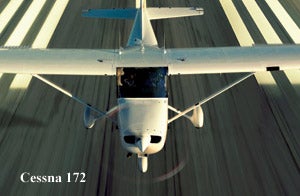 The Cessna 172
The Cessna 172
Hands down, the 172 has introduced more people to personal and business flying than any other airplane. The 172 began life in 1956 and, today, there are more than 25,000 still flying. The new-generation 172 was introduced in 1997 as the 172R. It came with a 160 hp Lycoming IO-360 engine and was designed for pilots already possessing or working toward an instrument rating. The 172R offered an impressive lineup of the latest King/Honeywell IFR avionics and a KLN-89B GPS (with moving map) as standard. A King KAP-140 autopilot was optional.
To stay competitive with the Piper Archer III, Cessna offered the upgraded 172SP, which came with a 180 hp Lycoming engine, in 1998. The 172SP quickly became the most popular model; the 172R is still available on special order, but at least 90% of all new 172s sold are the 180 hp "SP" model.
With the exception of the optional 180 hp engine and an optional King HSI, there were very little changes to the 172 between 1997 and 2004. In that year, Cessna introduced its first piston, glass-cockpit airplanes, the 172SP and the 182T. The simple, easy-to-fly, economical four-seater that introduced thousands to flying was now better-equipped than many commercial airliners. The Garmin G1000 came standard in all 2004 and newer 172SPs.
The 172R and 172SP cruise at approximately the same speed (110 knots on 9 gph), though climb performance is noticeably improved on the 172SP. A 2008 C-172SP costs about $255,000, depending on final options; a used glass-cockpit (2004 to 2007) 172SP will run about $180,000; and a good-condition 2000 C-172SP with low hours and little if any student-training history will cost about $120,000. The early 172Rs (1997 and 1998) with mid-time engines sell for about $85,000.
Compare flying a '60/'70s model 172 with a new-generation 172, and you'll quickly see the differences and why pilots are willing to spend extra money for a new or near-new airplane with significantly improved avionics. There are no significant maintenance issues to watch for on any of the newer 172s. It's just a great, simple, affordable, easy-to-fly family single that has justifiably earned its place in the hearts of thousands of pilots.
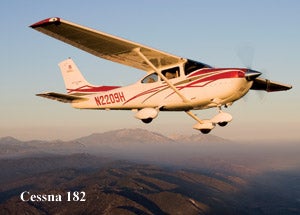 The Cessna 182
The Cessna 182
What if you took the world's most popular single-engine airplane and made it even better? You'd call it a new Cessna 182. Like the 172, the 182 was introduced in 1956. It offered the same ease of handling, comfort and simplicity of its little brother, the 172, but it also had more speed and better high-altitude performance. Hot-and-high performance was remarkable, mountain flying was a breeze and the aircraft offered a decent 150 mph on cross-country trips. The 182 design proved so perfect that Cessna kept the same powerplant and made only cosmetic styling changes for 30 years (1956 to 1987).
In 1997, Cessna resumed production of the 182 in its new incarnation, the 182S. Even the newer 182 is still the same basic airplane as its 40-year-old cousin (the only major changes, beyond styling, are a Lycoming IO-540 rather than a Continental engine; leather seats; and a fancier, standard King digital avionics stack). A turbocharged model was introduced in 2001; the next major change came in 2004 with the introduction of the Garmin G1000 as standard equipment. The 182 is a true 150 mph airplane on about 15 gph.
The 2008 glass-panel 182 lists at about $370,000. The earlier new-generation 182S (1997 and 1998) runs about $160,000; the next group, the 182T (2001 to 2003), will sell for $200,000 to $220,000; and the early G1000 182 (2004 and 2005) will run $235,000 to $250,000, depending on hours.
The new 182 may offer one of aviation's best overall values and capabilities; on the glass-panel airplanes, it's common to see the optional equipment include traffic avoidance, weather downlinks and XM Stereo. With Frank Sinatra or Mick Jagger playing on your headset at 10,000 feet and 150 mph on a beautiful sunny day, in an airplane so simple that anyone can handle it safely, can personal flying get any better than a 182?
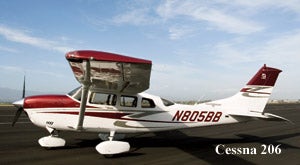 The Cessna 206
The Cessna 206
Do you have a big family? Do you need to travel to short, unimproved runways with the family dog, baby stroller and enough luggage for a month? If so, and you can't spend $3 million for a new Pilatus PC-12, you're probably flying a Cessna 206 (or a 180 or 185, but we'll get to those). The days of the air-taxi operator flying 206s are almost gone---except for in Latin America, Africa and Alaska. Today's typical Cessna 206 owner is more like this:
Mr. Bob Cavrell, owner of a Cessna 206, is a private pilot with a noncurrent IFR rating. Recently, his wife inherited a valuable antique piano that was 400 miles away. Not trusting a moving company with the valuable family heirloom, she enlisted her husband and the 206 to retrieve the prized antique. By removing all the seats (except the pilot's), and using the two large cargo doors and some careful maneuvering, Bob got the piano into the 206 and safely delivered it to his wife three hours later. Try that with FedEx. That's why Cessna 206 owners universally adore their airplanes.
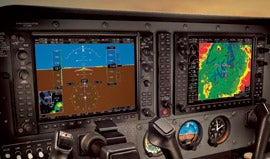 |
| The Garmin G1000 glass-panel system comes standard on Cessna 182 aircraft. The standard "six-pack" is shown on a primary flight display, and a moving map with terrain and weather overlays is on the multi-function display. |
Following the overwhelming success of the 172 and 182, Cessna reintroduced the 206 in 1999. Two versions of the 206 were offered: a turbocharged model and a normally aspirated model. The new 206H was introduced with a full King/Honeywell IFR panel, corrosion-proofing, optional float-fittings and a 300 hp Lycoming IO-540 engine. The airplane remained virtually unchanged from 1999 to 2003. In 2004, Cessna also added the Garmin G1000 to the 206 line. All 206s are easy to fly, roomy, excellent on short/rough fields and easily handled by low-time pilots. There's nothing negative about the airplane. Figure a solid 150 mph on about 18 gph.
A 2008 G1000-equipped 206H will run almost $500,000; a new-generation (1999 to 2003) 206 starts at about $240,000. A near-new glass-cockpit 206H (2004 and 2005) will sell for around $350,000. Whether you need to haul oil drums in the Amazon, tourists on photo safaris in Africa, plywood to remote villages in Alaska or just Sam the golden retriever and an occasional antique piano, think of a 206 as a flying Chevy Suburban, because that's exactly what it is.
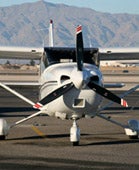 Which Cessna Is Right For You?
Which Cessna Is Right For You?
What kind of flying do you realistically do? What's a typical trip 70% of the time? And what can you easily afford? Each of the aforementioned planes is terrific, but to decide which Cessna best fits your travel or mission needs (and comfortably suits your checkbook), examine your flying profile, honestly assess your requirements and talk to a few Cessna owners and pilots. Ultimately, you can't go wrong with any of the new Cessna singles, but for you, right now, which one is best? Decisions like these are the best problems to have.
More Classic Cessnas
Cessna 150/152
The simple, forgiving and highly economical 150 and 152 made flying lessons fun and affordable and motivated people to try flying on a huge scale. Between 1959 and 1977, more than 20,000 Cessna 150s were built. The new and improved 152 had a Lycoming engine that could more easily handle the transition to 100LL octane than the 150's Continental O-200A. Prices range from $12,000 and up, for an older 150, to an average of $25,000 for a top-quality 152.
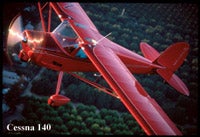 Cessna 140/170
Cessna 140/170
As early as 1946, Cessna---wisely identifying the post-WWII private flying boom---was producing an economical two-seater with an 85 hp Continental, which zipped along at 90 mph and sold new for $3,500. Cessna was always ready with something bigger and better, and the 170 was born in 1948. It carried four full-sized adults and would hit 105 mph reliably; it sold new for $5,900. Today, a decent 140 is $14,000 and a sharp 170B can easily cost $40,000.
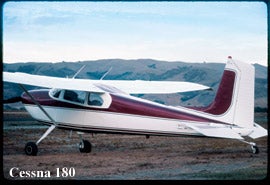 Cessna 180/185
Cessna 180/185
Can you say "macho rocket ship"? Introduced in 1953, the 180 carried four adults at good speeds (150 mph) and would land and takeoff literally anywhere you could imagine. Climb performance was phenomenal, and the airplane was a true workhorse. The 180's big brother, the 185, was introduced in 1961 with a 260 hp engine and six seats; it had essentially the same airframe, just beefed-up. A 300 hp engine became standard in 1966. Production lasted until 1981 for the C-180 and 1985 for the 185. A new 180 was $13,000 in 1953; today, a nice 1953/1954 model brings $60,000. A new 185 in 1961 was $18,950. Today, don't come to class without at least $95,000 in your pocket for a good-quality one.
Cessna 175
This was a great concept that just didn't work. The idea was to offer a faster 172, using the same engine but gearing it up to go faster and gearing the prop down to stay within its limits. The net result was an engine doing a lot more work than it was originally designed to do, and it showed in much higher maintenance costs and a lower TBO. The engine is so problematic that some shops won't overhaul it because it's so sensitive, making it difficult to accommodate the owner. Like the Ford Edsel, some owners swear by them, but most mechanics swear at them. Best to avoid this low-production Cessna model in favor of a 172 or 182. Today, stock 175s sell for about $22,000, and the retrofitted O-360 Lycoming engine models can bring between $38,000 and $40,000.
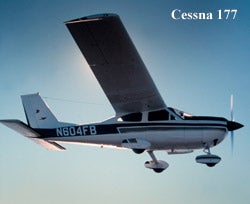 Cessna 177
Cessna 177
This Cessna has a virtual cult following. Cardinal buyers want only a Cardinal; they will accept nothing else. The Cardinal was introduced in 1968 as a sleeker and sexier 172. This wider airplane sat lower to the ground and the pilot had terrific visibility (only in the Skymaster and the Cardinal does the pilot sit in front of the wing). In the first year, sales were disappointing because it was underpowered---using the same engine, the O-320, as the 172 on a larger airframe wasn't a great idea. Landing and takeoff were "different" by virtue of an all-flying stabilator, as opposed to a fixed horizontal stabilizer with a moveable elevator. Cessna quickly replaced the powerplant in 1969 with a 180 hp O-360 engine, and a new wing design arrived in 1970. A retractable-gear version was added in 1971. Production ceased in 1978 for both models.
An important note: Many Cardinals have been successfully outfitted with hand controls for disabled pilots. The airplanes' low-to-the-ground stance and huge, wide doors make it easy for a wheelchair-bound pilot to get in, load the chair in the back and fly without assistance. While Cardinals were extremely difficult to sell in the late 1960s and were eventually replaced by the Hawk XP, today they're now quickly scooped up on the used market by eager Cardinal fans. An early, 150 hp Cardinal sells for around $32,000; a later 177B with the O-360 engine and newer wing brings $45,000 to $60,000; and a good-condition, late-model Cardinal RG can hit $75,000.
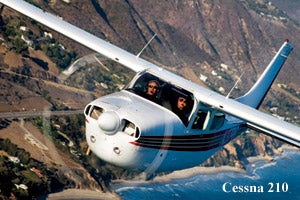 Cessna 210
Cessna 210
Feeling the need for speed? Want a roomy and comfortable six-seater that an average pilot can fly? Need decent short-field performance, good climb, good mountain performance and a stable IFR platform for a reasonable price? Look at the 210.
The 210 was born in 1960 as a retractable-gear 182 to compete with the V-tail Beech Bonanza. The major model changes for 210s were: 1962 for the rear window; 1964 for the 285 hp engine; 1966 for optional turbocharging; 1967 for elimination of the wing struts; 1970 for the larger fifth- and sixth-seat area and tubular gear; 1977 for the 300 hp engine; 1979 for optional full deicing; and 1984 for the 325 hp engine.
Like a Bonanza, nosegear collapses are fairly common on 210s and aren't considered a major sin if repaired properly. The key to a successful ownership experience on the 210 (and all older, high-performance retractables) is who has been doing the annuals and whether the owner was willing to spend the extra money to properly maintain the airplane. On early 210s, be sure to have a competent 210 mechanic check the gear-actuating mechanism. The most problematic years for the gear were 1960 through 1966, but Cessna has good fixes for most of the gear issues.
A late-model 210 in many cases does a better job than most light twins at half the operating costs; it's a luxury people-hauler and an impressive ride for family members and business clients alike.
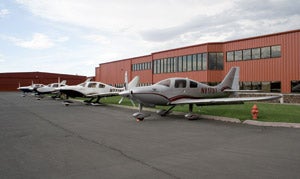 Paying For Your Cessna
Paying For Your Cessna
Financing
If you're thinking about aircraft financing, now is a terrific time to get an airplane loan. Rates and terms have never been more favorable. Friendly aviation bankers are eager to help you get a loan. The major criteria that they're looking for is very simple: Can you reliably pay them back? The approval process is quick and easy. Here's how to get started:
1. Call one of the aircraft bankers listed below. They will obtain credit bureau reports for you and start the application process. You'll need a credit score of at least 650, but there are exceptions if there are other strong factors in your favor. Each bank varies in its credit requirements.
2. You'll need to furnish two years' worth of tax returns to prove that you have adequate income to make your airplane payments and pay your existing bills.
Now, you should consider how much money you can get. Should you purchase a $25,000 Cessna 172 or a $250,000 pressurized P210? How much of an airplane loan do you qualify for?
Inside tip: Most airplane bankers want to see a debt-to-income ratio of about 45:100. In plain English, this means that the total of all your regular monthly obligations (car, house, credit-card minimums, etc.), including your proposed airplane payment, doesn't exceed 45% of your gross income before taxes. For example, if you make $5,000 a month, your total monthly obligations shouldn't exceed $2,250 (which includes the airplane payment); if your monthly gross income is $10,000, then it's a maximum of $4,500 per month. There can be some flexibility in this, especially for people who are self-employed with strong business cash flow and excellent personal credit. Bankers often define excellent credit as a score of 720 or above. Knowing your credit score, income and these parameters will give you an idea of the loan size you'll most likely be approved for.
Your interest rate, down payment and loan term will be based on your credit and the bank's guidelines at the time of your application. Here are some industrywide examples, at this writing:
Term: The average term for a used Cessna is 20 years. Some banks will go to 25 years for the newer, more-expensive models, and 10 years for the lower-priced, older Cessna singles (140s and $25,000-range 172s).
Rate: With the vendors listed here, the average rate on a $100,000 used Cessna single is 6.8%. A $50,000 Cessna would be about 7.35%, and for the older, $20,000- to $25,000-range Cessnas, expect about 9.5%
Down payment: Almost universally among all the listed financial sources, the down payment will be 10% to 15% with good credit.
Each bank has its own criteria for aircraft age and loan amount. Most lenders have a $25,000 minimum, but Allied First Bank in Oswego, Ill., will consider under-$25,000 airplanes; Randy Aarestad, President of Red River State Bank in Halstad, Minn., is a pilot with a program for under-$25,000 airplanes. Take advantage of some great rates and terms on airplane loans. Your dream Cessna can be in your hangar quicker than you think!
| Resources: | ||
| Airfleet Capital | www.airfleetcapital.com | (800) 390-4324 |
| Allied First Bank | www.alliedfirst.com | (800) 272-3286 |
| Cessna Finance | www.cfcloan.com | (866) 232-5626 |
| Dorr Aviation | www.dorraviation.com | (800) 214-0066 |
| Red River Bank | www.airloan.com | (800) 472-1754 |
| U.S. Aviation Finance | www.usaviationfinance.com | (888) 654-8723 |
Insurance
Insurance is easy to get, and it's an important part of buying and financing your Cessna. Lenders will require full coverage on your airplane with the bank named on the policy as loss-payee and breach-of-warranty. Here are the main points that an insurance company will consider to determine your insurance rates:
IFR ticket: It's helpful on six-seaters, turbocharged airplanes and retractables. It will save you enough in insurance premiums to practically pay for the rating.
Hangar vs. tiedown: Hangaring will save you about 5% on the hull rate with most underwriters.
Total time and time in type: For retractables and tailwheel models, this is important in determining your insurance rate. For example, the insurance fee for a $50,000 Cessna 210 is about $3,000 yearly with a low-time, VFR pilot. A $150,000 1980 T-210N costs about $3,500 per year with an IFR-rated pilot who has 500 total hours (10 in the type and 30 in retractables). The T-210N, which costs three times the hull value of the other model, costs almost the same price to insure as the $50,000 Cessna 210 with a low-time pilot. An instrument rating and hours-in-type will bring your rates down considerably. What's better than flying and saving money?
| Resources: | ||
| Avemco | www.avemco.com | (888) 241-7891 |
| Aviation Insurance Resources | www.air-pros.com | (877) 247-7767 |
| Wenk Insurance | www.wenkinsurance.com | (847) 433-8370 |

Subscribe to Our Newsletter
Get the latest Plane & Pilot Magazine stories delivered directly to your inbox





